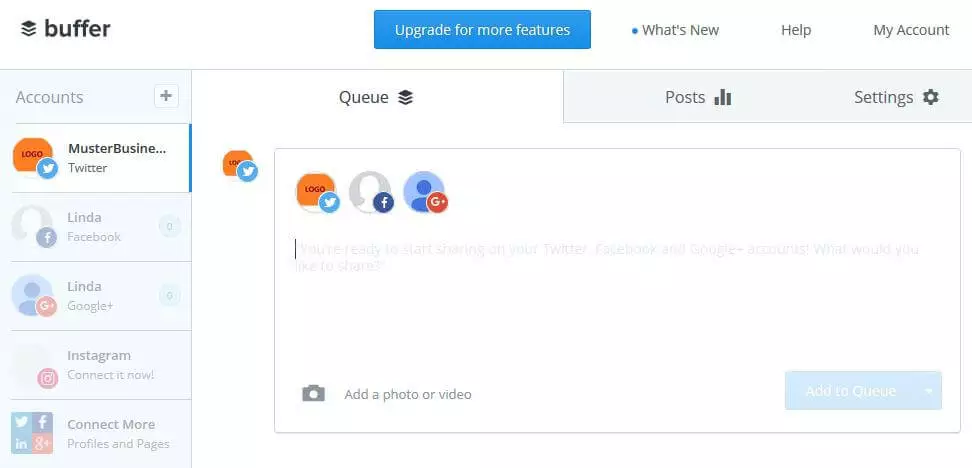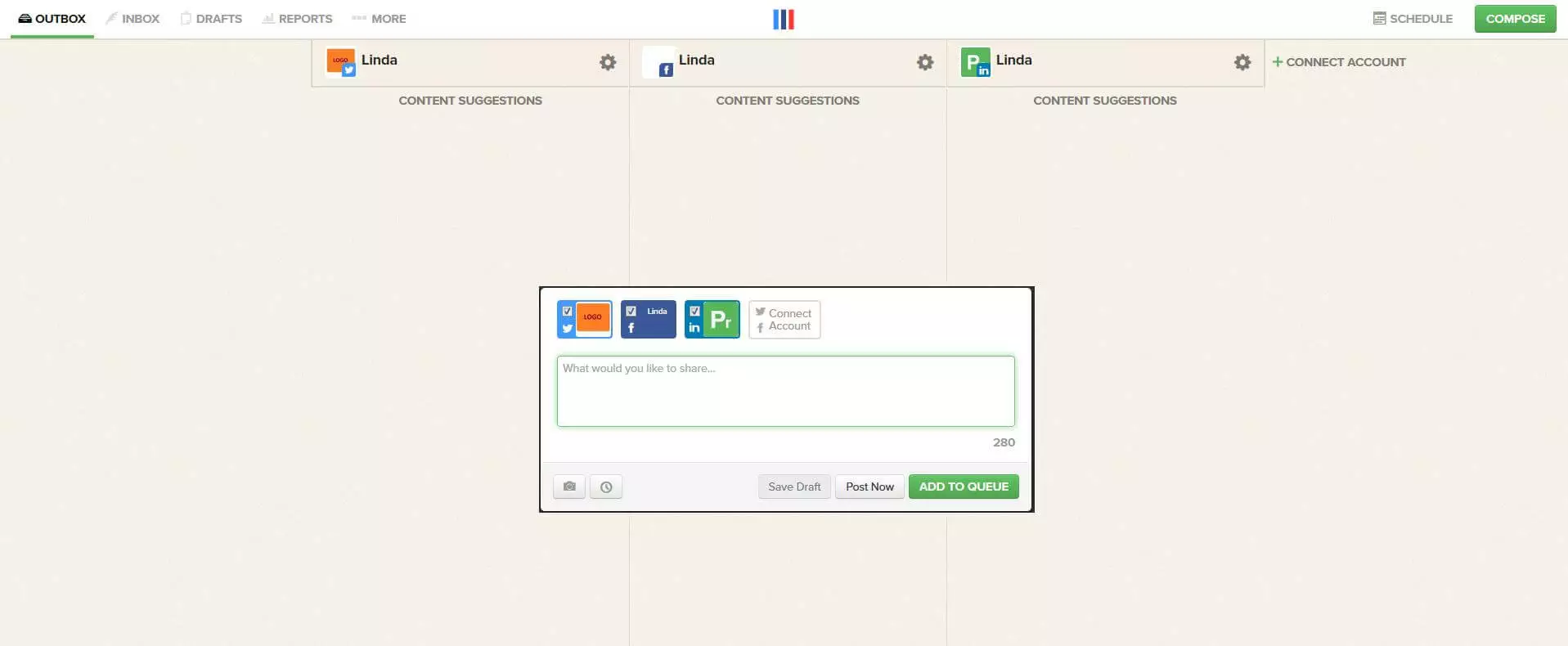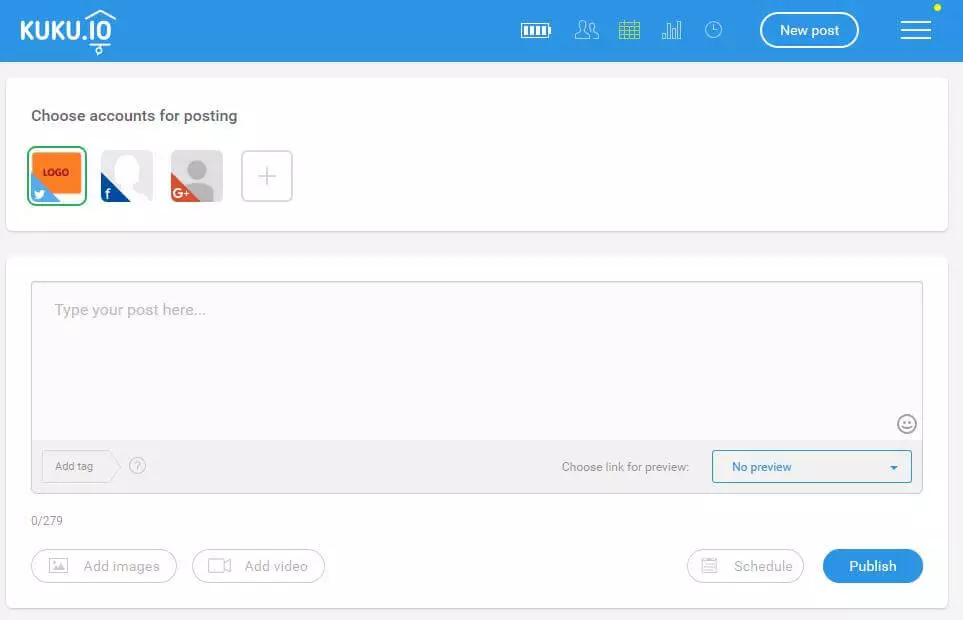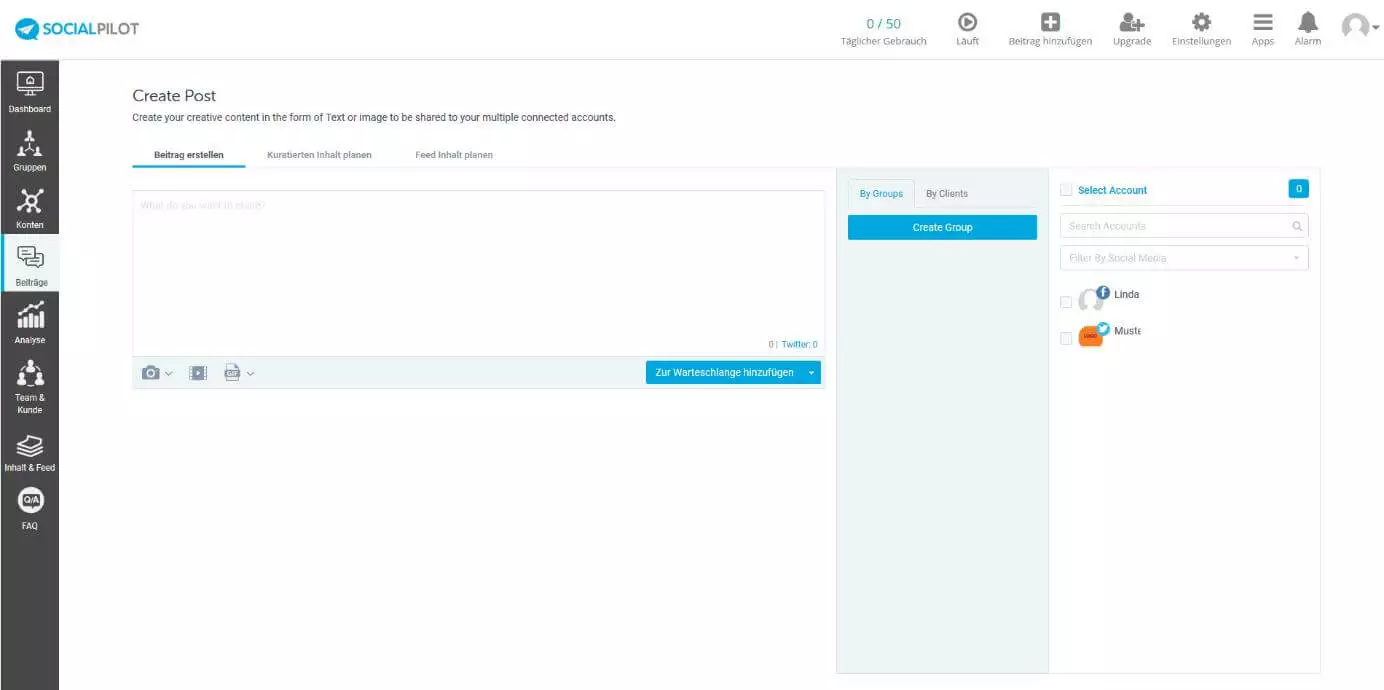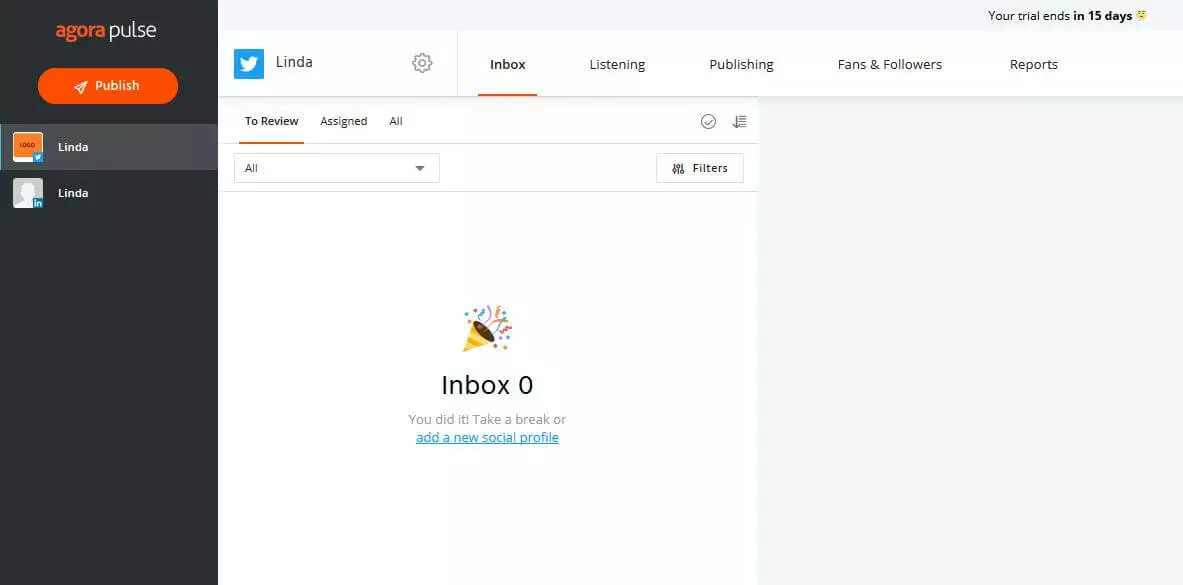Hootsuite alternatives: what do other social media tools have to offer?
Hootsuite is a practical tool for managing various social media channels. Hootsuite enables users to make their social media strategy more efficient by connecting multiple accounts. For example, users can plan and control the publication of social media posts. Additionally, there are a number of useful analysis tools available to customers.
When used correctly, Hootsuite can save a lot of unnecessary work spent on individual social networks, by combining all your channels on one single platform. In addition, Hootsuite is also a useful tool for monitoring social media. Hootsuite currently supports 35 different social networks globally, including Facebook, Google+, Instagram, Twitter, and Pinterest.
In terms of design, Hootsuite is based on popular, interactive boards, which has proven to be a very successful strategy. The online tool is also suitable for teams to communicate effectively with their target groups. The SaaS-based platform is quick and easy to access and can be used by multiple employees at a time. It’s not without reason that Hootsuite is an award-winning tool in the modern business world.
What are common problems with Hootsuite?
The tool has several problems that make considering Hootsuite alternatives worthwhile.
- Hootsuite is often criticized for its lack of involvement in modern web developments. The last design update took place over 3 years ago. The tool is lacking some current design trends, such as a more uniform activity feed and extensive settings. Such factors make the tool seem slightly antiquated. In addition to this, the Hootsuite interface is not very user-friendly and takes quite a bit of getting used to and training.
- The program still doesn’t allow users to manage the visibility of comments. Toxic comments remain visible for a long time and can cause damage to a company or individual. Negative comments on Facebook can have a particularly bad impact. This is a problem that Hootsuite fails to recognize.
- There is a lot of controversy surrounding the inadequate integration of the social media heavyweight Instagram. Users don’t receive new posts sorted individually, but have to search for them in the respective photo threads. For a platform with the sole purpose of making social media easier, this is very aggravating. After all, the point of the tool is to be able to communicate with your target group quickly and easily – this proves more difficult if new posts and comments are not displayed.
- In terms of payment, Hootsuite is a relatively expensive platform. The free version only supports a maximum of three social media accounts and does not allow for teamwork – even smaller businesses will have to reach into their pockets at some point. For USD 19 a month, one user can work on up to 10 social media profiles. For around USD 99 a month these numbers increase to three users and 20 profiles. Companies with more than five colleagues that require access to Hootsuite must inevitably negotiate the enterprise model, which supposedly costs somewhere between USD 800 and 1,200 a month per user. Certain special analysis tools can increase the monthly flat rates. The cost of Hootsuite can explode if you want to run extensive social media management.
- Hootsuite doesn’t have the best reputation when it comes to support: there is no telephone support available and the e-mail support is considered to be poor and slow. Because the support is mostly focused on enterprise customers, small businesses and individuals are often ignored when experiencing problems with the platform. In a fast-moving industry like social media, this can be fatal.
The best Hootsuite alternatives
Below, we introduce a number of noteworthy Hootsuite alternatives – some of which are free while others come at a price.
Buffer
With Buffer, users can publish content on various social networks; profiles from Facebook, Twitter, LinkedIn, Google+, Instagram, and Pinterest can be connected. The program uses a so-called queue for planning posts. Individual posts can be published on one or more networks. Regular automated content sharing is also supported by the queue function. Posts can include text, articles, videos, images, and lots more. Integrating media can also be done easily via Buffer.
The algorithm of the queue function is very sophisticated and can save users a lot of time. The tool can even time the publication of your content when it is most likely to be noticed by your target audience. Buffer also supports convenient browser extensions and is available as a mobile app for both Android and iOS. Extensive analysis tools provide users insight into the success of your marketing strategy or, more generally, the reach of your social media. The “Pablo” feature is a useful image editor tool that can optimize images for each network. The offer is completed with integrated RSS feeds.
For individual users, the free version is extremely helpful. An expanded version costs around USD 15 a month. Teams that want to work together with Buffer require the business version, which, depending on the number of team members, can cost anywhere between USD 99 and 399.
| Advantages | Disadvantages |
|---|---|
| Facebook, Twitter, LinkedIn, Google+, Instagram, and Pinterest are supported | The pricing model penalizes teams under 5 members as businesses are still charged for 5 members |
| Queue feature enables innovative planning of social media posts | Limited integration with Instagram; cannot be used to post there |
| Pablo feature optimizes images for each network | |
| RSS feeds generated on request |
Stacker
With Stacker, users can manage their Facebook, Twitter, LinkedIn, and Pinterest accounts; it allows users to post on multiple platforms at the same time and schedule certain posts. Users can communicate directly with other users who write or mention one another on social networks.
The convenient analysis tool summarizes interesting statistics; users can see at a glance exactly how many likes, retweets, shares, views, and comments a post has received. Stacker’s timeline can be used to measure the success of social media posts, and as a whole, the program has an attractive and tidy appearance, with individual accounts divided into different tabs that can be accessed any time.
For individual users, the Hootsuite alternative offers a free version that can contain 4 accounts. The “Amazing” version allows one employee and up to 12 accounts and costs around USD 10 a month. The “Team” plan costs USD 50 a month and allows up to 5 employees and 25 accounts, while the “Studio” version costs USD 100 per month and provides for up to 10 employees and 50 accounts. Finally, the most expensive plan, “Agency,” comes at the price of USD 250 per month with 25 employees and 150 accounts. The more you pay, the larger the timeframe for reports. Best suited for teams of up to five or individuals, Stacker is a relatively cheap alternative.
| Advantage | Disadvantages |
|---|---|
| Facebook, Twitter, LinkedIn, and Pinterest are supported | Does not support Instagram or Google+ |
| Relatively inexpensive; free version is best suited for individual users | No optimization tools for posts |
| Appealing design, easy to use |
Kuku
Kuku only began in 2015 and has still got space for development. However, it is already supported by a broad selection of social networks including Facebook, Twitter, Pinterest, Tumblr, and LinkedIn, as well as the Russian networks vk.com and ok.ru. Both Reddit and Google+ are planned to be integrated in the future. Important features like CRM tools and API support are still missing, but are in planning. Kuku is most certainly not the complete service yet.
The interface is surprisingly minimalistic; the focus lies on creating and sharing posts. These posts are gathered in the “Channels” area and provide a convenient overview of all activities. Analysis data can be accessed via the dashboard, but is only available with the paid version.
The Kuku pricing model is very simple. The Hootsuite alternative offers a free version with just one user, or you can pay around USD 30 a month per user for team-based work that is supported by analysis tools.
| Advantages | Disadvantages |
|---|---|
| Facebook, Twitter, LinkedIn, Pinterest, Tumblr, vk.com, and ok.ru are supported | Currently does not support Instagram or Google+ |
| Inexpensive platform; free version is ideal for individual users | No CRM tools, no API integration |
| Attractive, minimalist design, easy to use | Has an unfinished feel |
SocialPilot
SocialPilot is mostly aimed at companies that want to combine social media management and CRM. The tool is considered a marketing platform that can save time and money when it comes to creating marketing strategies and overseeing campaigns. With SocialPilot, updates, posts, tweets, etc. can be shared and scheduled. To do so, the tool optimizes content for each respective platform. SocialPilot supports Twitter, Facebook, LinkedIn, Instagram, Pinterest, Tumblr, vl.com, and ok.ru – the program has the broadest offering in comparison to its competitors.
In terms of design, SocialPilot is more complex than its competitors but does however score points for its depth in features like branding, scheduling posts, calendar, browser extensions, analysis tools, and client management. Due to the increased complexity, SocialPilot requires some time to get used to and should be considered an expert program. Its branding feature is especially helpful for Facebook posts and is particularly worthwhile for medium to large businesses. The more important your brand is, the more valuable SocialPilot will become.
The free version of SocialPilot allows 10 posts per day with a maximum of three accounts, and leaves out a number of important features. The “Individual” version on the other hand, costs USD 10 per month, permits one user, and allows up to 10 profiles and 50 posts a day, but is still missing various important features. The “Professional” version comes at a monthly fee of about USD 30 and is a more team-oriented model that allows for up to 5 collaborators, 50 accounts, and 200 posts a day. The “Small Team” version allows for up to 10 users and 100 accounts, and offers 500 posts for around USD 50 a month. The “Agency” version costs approx. USD 100 a month and allows for 20 users and 200 social accounts.
| Advantages | Disadvantages |
|---|---|
| Facebook, Twitter, LinkedIn, Instagram, Pinterest Tumblr, vk.com, and ok.ru are supported | Currently does not support Google+ |
| Relatively inexpensive platform | Free version is very limited |
| Large number of features and tools in the paid version | Complex and not very user-friendly |
AgoraPulse
AgoraPulse is marketed as a social media marketing solution. As well as conversation threads, the platform offers dashboards, schedules, and tracking for all posts, a keyword search and keyword filter, countless reports and statistics, different permissions for users, and lots of useful apps for creating posts. AgoraPulse supports Facebook, Twitter, and Instagram, with all posts and feeds combined in the “Inbox Zero”, the core concept of the software.
The tool stands out with its excellent design and user-friendliness, both making the tool very pleasant to work with. Users can navigate easily between individual social media accounts and the different functions in the various tabs. Overall, AgoraPulse is a very elegant platform.
One of the downsides of the tool is the shortage of integrated networks. As long as AgoraPulse, for example, does not support Pinterest or Google+, the tool is unfortunately not the complete solution for many companies. For this reason, it is a relatively inexpensive option. After a two-week free trial in which users can try out all features, you then have to decide on one of the following models: “Small,” with 1 profile, costing around USD 49 a month, “Medium” with 3 profiles and costing USD 99 a month, “Large” with 6 profiles and costing USD 199 a month, and “Enterprise” with 12 profiles and costing USD 299 a month. The decisive factor here is that even the cheapest model contains all important features, making AgoraPulse a particularly attractive solution for individual users.
| Advantages | Disadvantages |
|---|---|
| Facebook, Twitter, and Instagram are supported | Does not support Google+ or Pinterest |
| Inexpensive platform, ideally suited to individual users | Free version only available for 14 days |
| Very good user-friendliness and a short training period | |
| Practical apps for the creation of posts |
Overview: Hootsuite alternatives
| Platform | Pricing model | Supported networks | Recommended for |
| Buffer | Free version (limited functions), Pro Starter 15 USD/month, Business 99–399 USD/month | Facebook, Twitter, LinkedIn, Google+, Instagram, and Pinterest | Individual users, small teams, small-medium businesses, associations |
| Stacker | Free version (up to 4 accounts), Amazing 10 USD/month, Team 50 USD/month, Studio 100 USD/month, Agency 250 USD/month | Facebook, Twitter, LinkedIn, and Pinterest | Individual users, small teams, small businesses, associations |
| Kuku | Free version (1 user only), Individual 7 USD/month, Smart 11.99 USD/month, Professional 16.99 USD/month, Business 29.99 USD/month | Facebook, Twitter, LinkedIn, Pinterest, Tumblr, vk.com, and ok.ru | Individual users, small teams, small businesses, associations |
| SocialPilot | Free version (functions are very limited), Individual 10 USD/month, Professional 30 USD/month, Small Team 50 USD/month, Agency 100 USD/month | Facebook, Twitter, LinkedIn, Instagram, Pinterest, Tumblr, vk.com, and ok.ru | Small teams, small-medium businesses, large businesses, associations |
| AgoraPulse | Free version (14 days), Small 49 USD/month, Medium 99 USD/month, Large 199 USD/month, Enterprise 299 USD/month | Facebook, Twitter, and Instagram | Individual users, small teams, small businesses, associations |


